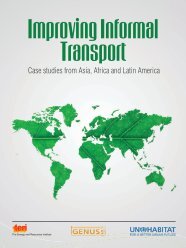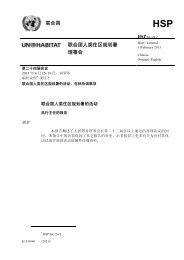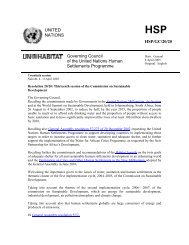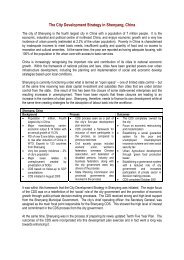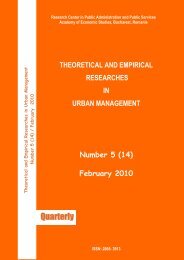Harmonious cities - UN-Habitat
Harmonious cities - UN-Habitat
Harmonious cities - UN-Habitat
Create successful ePaper yourself
Turn your PDF publications into a flip-book with our unique Google optimized e-Paper software.
COVER STORY China and India: a telling contrast<br />
Gangtok - just one of India’s growing <strong>cities</strong> Ph o t o © Su B h A d i P mu k h er j ee<br />
sky-scrapers, sometimes with local refinements<br />
perceived as kitsch or ostentatious by<br />
foreigners, contrasts with an unhidden national<br />
pride, and among the middle and upper<br />
classes, a sharp competitive spirit and an almost<br />
blind faith in the future and the unlimited<br />
prospects of Asian capitalism.<br />
A brief comparison with the Western<br />
world<br />
China and India demonstrate once again<br />
that <strong>cities</strong> are simultaneously the cause and<br />
consequence of development, that there is a<br />
direct correlation between urbanisation and<br />
socio-economic progress. In his masterful<br />
synthesis on city history Paul Bairoch tested<br />
and illustrated this law in many regions during<br />
various periods of time. And it emerges<br />
clearly out of our Sino-Indian comparison.<br />
While Chinese urbanisation has been<br />
traditionally self-centred, at least until the<br />
19 th century, its dynamics have completely<br />
changed since the 1980s. Its recent expansion<br />
can be compared with the process followed<br />
by the United States a century ago, between<br />
1880 and 1930, i.e. with a concentration on<br />
coastal areas (East Coast and California in<br />
the USA, East Coast in China) and in a large<br />
inner employment basin (one could suggest a<br />
18<br />
u r b a n<br />
WORLD<br />
November 2008<br />
fascinating parallel between Chongqing and<br />
Chicago, and between Sichuan and the American<br />
Midwest). Obviously Shanghai is becoming<br />
the new New York and Pudong intends to<br />
challenge Manhattan. The main difference is<br />
that US <strong>cities</strong> were working primarily for the<br />
domestic market and Chinese <strong>cities</strong> target in<br />
priority external markets (although the Chinese<br />
domestic market is also expanding fast).<br />
But the growth rate is similar. Traditionally<br />
introvert China has become extravert in a<br />
single generation.<br />
The spatial development of India looks<br />
more like the one of continental Europe<br />
around 1800, with a hierarchised urban network,<br />
under-developed pockets corresponding<br />
to the most rural regions and deficient infrastructure.<br />
In fact the Indian economy is an<br />
archipelago economy, made of high-tech islands<br />
surrounded by an under-equipped hinterland.<br />
Extravert until 1947, India became<br />
introvert during more than 40 years, until the<br />
reform of 1991 that initiated a vast liberalisation<br />
process (a well publicised success of the<br />
IMF), still on-going.<br />
Chinese and Indian <strong>cities</strong> appear to have in<br />
common the abolition of the centre-suburb<br />
dichotomy, which constitutes a feature of<br />
both European <strong>cities</strong> (which have a rich cen-<br />
tre) and American <strong>cities</strong> (where the wealthy<br />
live in suburbs). With some exceptions (e.g.<br />
Bangalore) Asian <strong>cities</strong> are becoming more<br />
and more multi-centred, due to the invisible<br />
hand of land markets and investor strategies.<br />
China and India are the new faces of capitalism.<br />
They have replaced Japan in the mind<br />
and fears of the Western hemisphere. Rightly<br />
so, for they clearly threaten rich countries<br />
by their dynamism and strategic positioning<br />
in the current globalisation of the world<br />
economy.<br />
As far as city management is concerned,<br />
the lessons emanating from our comparison<br />
are clear, albeit not extraordinarily original:<br />
one must decentralise according to the subsidiarity<br />
principle, invest more in urban and<br />
inter-city infrastructure, adopt modern cutting-edge<br />
methods and technologies (such as<br />
satellite-based urban information systems),<br />
try to improve the quality of life to make <strong>cities</strong><br />
more attractive, promote metropolitan<br />
regions or urban corridors associating <strong>cities</strong>,<br />
towns and rural areas and favouring intraregional<br />
synergies. Only then the current<br />
process of “glocalisation” (more local politics,<br />
more global economy) would benefit more<br />
countries, in the north and the south. A lot<br />
remains therefore to be done at local and subnational<br />
(regional) levels, including in OECD<br />
countries, at a time when the announced<br />
decline of nation-states becomes a tangible<br />
reality.<br />
In China and India, <strong>cities</strong> are the locomotives<br />
of the new growth models. In spite of<br />
some heavily loaded wagons they pull the<br />
economy in the right direction, and this is<br />
reflected not only in their foreign trade performances,<br />
but also in the reduction of poverty<br />
and in a new, yet insufficient concern for<br />
the environment.<br />
Urban specialists should devote more attention<br />
to the evolution of these booming <strong>cities</strong>.<br />
They are driving the current Asian revolution.<br />
The old Chinese saying: “if you want to be<br />
rich, you must first build roads” is once again<br />
confirmed in the 21 st century.<br />
Born in France, Daniel Biau, is an Urban<br />
Planner and a Doctor in Social Sciences,<br />
specialised in urban and housing policies.<br />
He has more than 30 years of international<br />
experience.




